Designing, building, and flying rubber-powered, multiengine airplanes
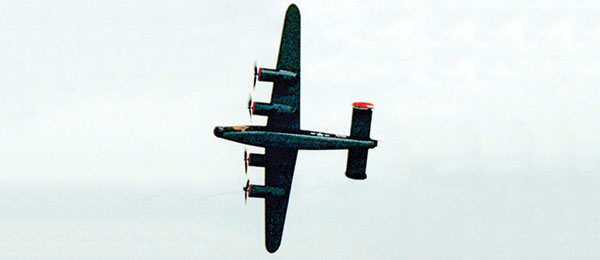
Written by Dennis Norman Free Flight Scale Column As seen in the December 2018 issue of Model Aviation.
Multiengine subjects for Free Flight (FF) Scale have long fascinated me. In 1984, I decided to build a four-engine, rubber-powered FF Scale model. The English Lancaster looked the most promising. With an actual wingspan of 102 feet, 1:24 scale (1/2 inch equals 1 foot) would yield a model with a 51-inch wingspan. Widely spaced nacelles would allow for propellers large enough for rubber power, and the model would be nearly the desired size. I knew that the model would have to be built lightly and, while reading a model boat building magazine, I saw a design technique that appeared suitable for my purposes. The boat builder made a solid wood mold to the inside dimensions of the boat then lightly waxed the mold, centered a piece of raw sheet balsa on its top, and hot stuffed the edges of wet laminations to the raw balsa until they matched the external dimensions of the hull.
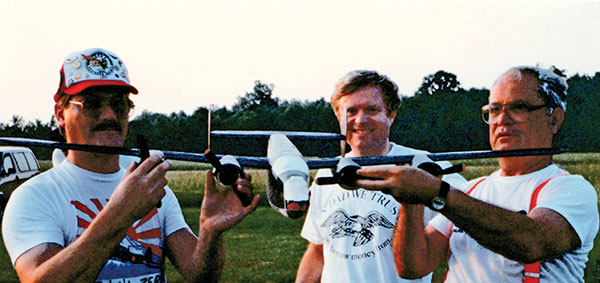
Although only partially completed, the B-24J is fully wound and ready to be test-flown by the author (center). Mike Thompson (L) and Del Balunek look on with approval. Photo by Konrad Balunek.
Following the builder’s method, balsa molds were carved for each vertical half of the fuselage and nacelles. This facilitated removal of the waxed molds after they had served their purpose. Fuselage and nacelle formers were laminated around the molds to a thickness of 1/16-inch square then 1/16-inch square stringers were added over these to reach the scale thickness. After everything had dried, the result was a light fuselage and nacelle structures. Wing and tail surfaces were built of 1/16-inch strip using the “cracked rib” method. The Lancaster that I built in this fashion had flights approaching 1 minute. A construction article was published in the June 1987 Model Aviation, beginning on page 89. Click here to download the article! I first thought of building a FF Scale B-24J not long after flight testing began in 1984 on my Lancaster. The B-24J had a slightly longer, but significantly narrower, wing. Although also utilizing four engines, it had shorter nacelles, meaning that a FF Scale B-24J configuration would have potentially less lift and power than the Lancaster. Keeping these limitations in mind, I decided to lighten the B-24J’s structure even more.
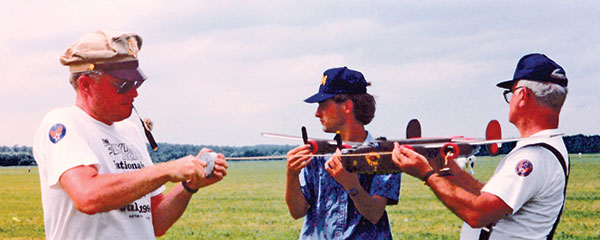
The author (L), with a propeller in his mouth, packs in the turns while Konrad Balunek (center) and his dad, Del, hold the model at the 1990 FAC Nats. Photo by Russ Brown.
Variations to improve the B-24J included deepening the back of each nacelle, adding a modest increase to the wing chord (to increase the wing area and subsequent lift), slightly enlarging the horizontal stabilizer, and using “box-type” construction for the fuselage. As did the Lancaster, the B-24J employed a torsion box in the fuselage. It was made from lightweight sheet balsa placed at the top. This resulted in a lighter structure and a more scalelike appearance. Construction of the B-24J began in late 1988. It was covered with Esaki Japanese tissue and sealed with one coat of Sig Lite butyrate dope. By the spring of 1989, test flights began. The model was stable and had good glide characteristics, but it was still unfinished and weighed approximately 2 ounces less than it would when it was completed.
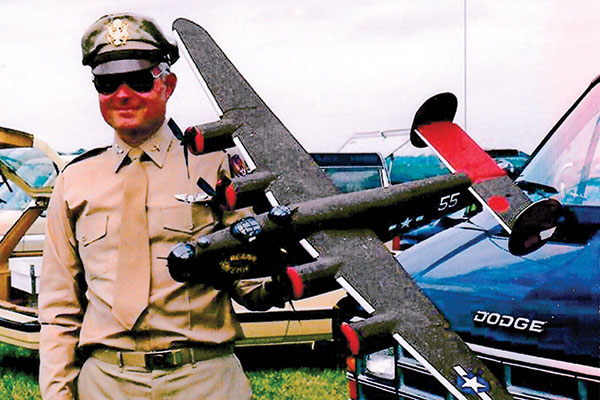
The appropriately uniformed author poses with his scratch-built B-24J between flights at the July 1990 FAC Nats in Geneseo NY. Photo by Tom Timmons.
When flight testing proved encouraging, I painted and finished the model. Color was applied from spray cans of Floquil paint (Roof Brown for the upper surfaces and a light gray color for the undersurfaces). The B-24J was published in the September 1997 issue of Flying Models magazine, where it was featured on the cover. A full construction article, plans, and photographs begin on page 54. Previously unpublished photos accompany this article.
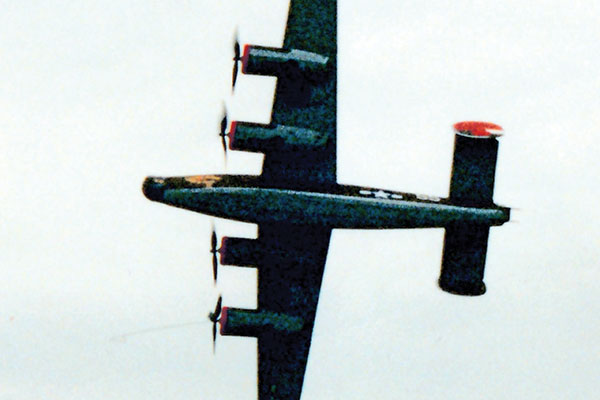
Seeing the FF Scale B-24J model soaring overhead is an unforgettable sight. Here, it heads out on another mission during the 1990 FAC Nats in Geneseo NY. Photo by Mark Fineman.
The Flying Aces Club’s (FAC) Chris Starleaf built a slightly enlarged B-24J from my plans and found that single-sheet tissue covering proved vulnerable to punctures from grass, etc. as his model landed. Chris solved this problem by double covering the bottom of the fuselage and the entire wing. He eventually achieved flight times of more than 80 seconds with his B-24J.
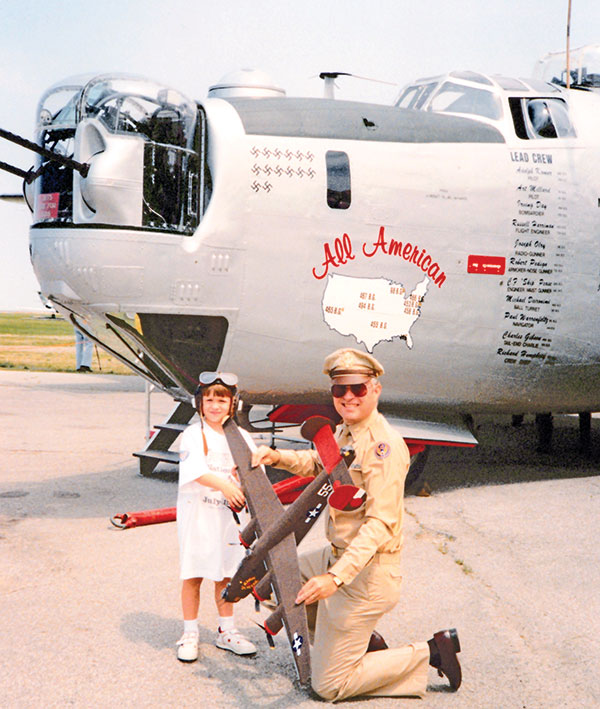
Six-year-old Patrick Norman poses with his dad and the B-24J model in front of The Collings Foundation’s full-scale B-24J during Labor Day weekend in Cleveland OH in 1990. Photo by Linda Norman.
My late colleague, George Nelson, flew B-24s during World War II. He told me that the airplane’s structure permitted wind to blow through the aircraft during flight with unnervingly loud sounds that were similar to screaming. This probably explained the name, “Screamin’ Meemie II,” which was the inspiration for the markings on my B-24J.
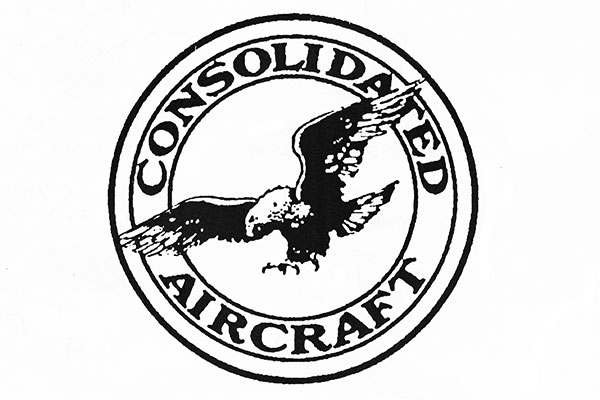
The B-24J Liberator’s Consolidated Aircraft manufacturer logo. Image from Consolidated Aircraft.
Because of my early efforts at building FF Scale multiengine aircraft, the members of the FAC have developed even more creative ways of building lightweight models. The future of multiengine airplanes is bright. If you have not tried them, I highly recommend that you do so. It will be challenging, but the result makes it worthwhile. -Dennis Norman [email protected]










Add new comment